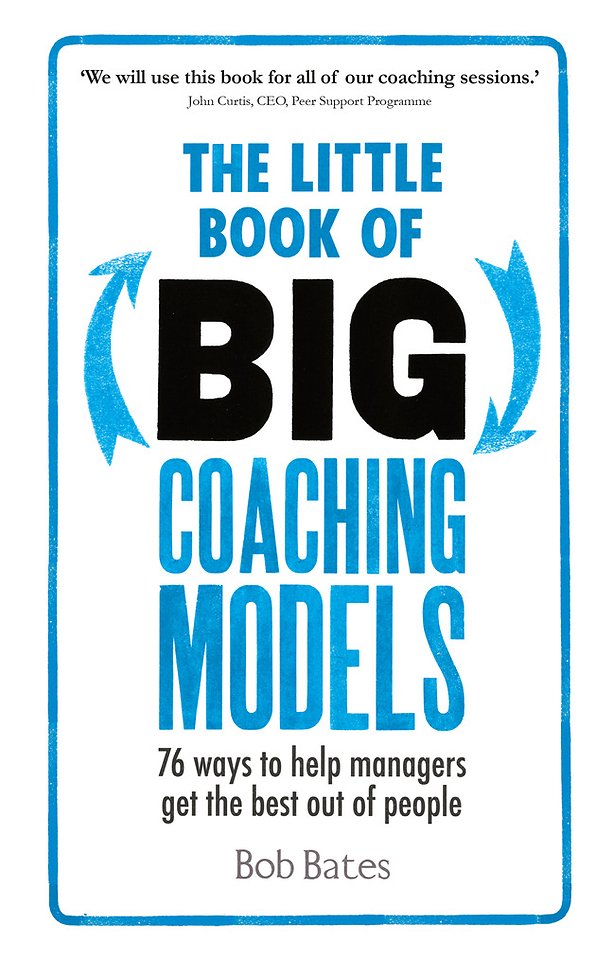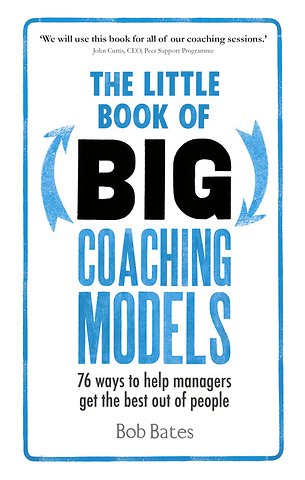Little Book of Big Coaching Models
76 ways to help managers get the best out of people
Samenvatting
De 'Little Book of Big Coaching Models' geeft u toegang tot de beste theorieën en modellen die iedere manager zou moeten kennen en toepassen. Bij ieder model laat de auteur zien wat het is en hoe u het model kunt toepassen zodat u de theorie direct kunt omzetten naar de praktijk.
Specificaties
Inhoudsopgave
PART 1: MAKING A START
Introduction
SECTION 1: UNDERSTAND HOW PEOPLE THINK AND LEARN
Introduction
1. Malcolm Knowles: How adults learn
2. Neil Fleming: VAK
3. David Kolb: Experiential learning cycle
4. Katherine Myers and Isabel Briggs: The Myers-Briggs Type Indicator
SECTION 2: UNDERSTAND WHAT MOTIVATES PEOPLE
Introduction
5. John Keller: The ARCS model of motivational design
6. Douglas McGregor: X and Y theory
7. Frederick Herzberg: Hygiene factors and KITAs
SECTION 3: BE A GOOD COMMUNICATOR
Introduction
8. Michael Argyle: The communication cycle model
9. Eric Berne: Transactional analysis
10. Joseph Luft and Harry Ingram: Johari windows
SECTION 4: SET THE RIGHT OBJECTIVES
Introduction
11. Benjamin Bloom: Levels in the cognitive domain
12. Ravindrakumar Dave: Levels in the psychomotive domain
13. David Krathwol and Benjamin Bloom: Levels in the affective domain
SECTION 5: COACHING THROUGH DIRECTING
Introduction
14. Ivan Pavlov: Classical conditioning
15. Edwin Guthrie: Contiguity theory
16. Robert Merton: Self-fulfilling prophecy
SECTION 6: COACHING THROUGH FACILITATING
Introduction
17. Abraham Maslow: Hierarchy of needs
18. Carl Rogers: Facilitation
19. Jack Mezirow: Transformational learning
SECTION 7: COACHING THROUGH SHOWING OTHERS HOW TO DO IT
Introduction
20. The Gestaltists: Insight theory
21. Karl Pribram, George Miller and Eugene Gallanter: Test-Operate-Test-Exit (TOTE)
22. Albert Bandura: Role modelling
SECTION 8: COACHING THROUGH STIMULATING
Introduction
23. Donald Hebb: Associative learning
24. Leon Festinger: Cognitive dissonance
25. Michael Merzenich: Neuroplasticity
SECTION 9: DEALING WITH CHALLENGING BEHAVIOUR
Introduction
26. Kurt Lewin: Reshaping behaviour
27. Peter Honey: Behaviour modification
28. Robert Hare: Psychopathic checklist
Summary of Part 1
PART 2: TAKING IT FURTHER
Introduction
29. Richard Bandler and John Grinder: Neuro-Linguistic Programming (NLP)
30. Gregory Bateson: Neuro-logical levels
31. Donald Broadbent: Filtering
32. Marty Brounstein: The Five Pillars for Building Commitment
33. Arthur Costa and Bena Kallick: The coach as a critical friend
34. Edward De Bono: The six thinking hats
35. Robert Dilts: The Disney creativity strategy
36. Gerard Egan: The skilled helper model
37. Ferdinand Fournies: Coaching discussion plan
38. Tim Gallwey: The inner game
39. Howard Gardner: Multiple intelligence
40. Andrew Gilbert and Karen Whittleworth: The OSCAR model
41. Daniel Goleman: Emotional intelligence
42. Bruce Grimley: The 7Cs coaching model
43. John Grinder: New Behaviour Generator
44. Richard Hale and Eileen Hutchinson: The INSIGHT coaching cycle
45. Peter Hawkins: The CLEAR model
46. Jon Kabat-Zinn: Mindfulness
47. Max Landsberg: The Tao of coaching
48. David Lane and Sarah Corrie: Purpose, perspectives and process
49. Angus McCleod: The STEPPPA model
50. Alec McPhedran: The GENIUS model
51. Eric Parsloe and Monika Wray: The Seven Golden Rules of Simplicity
52. Jenny Rogers: The Six Principles of Coaching
53. Virginia Satir: Anchoring and self-coaching
54. John Sweller: Cognitive load theory
55. John Whitmore: The GROW model
Summary of Part 2
PART 3 COACHING THE ORGANISATION FOR BETTER PERFORMANCE
Introduction
SECTION 1: COACHING ORGANISATIONAL LEADERS
Introduction
56. John Adair: Action-centred leadership
57. Bernard Bass: Transformational leadership
58. Richard Boyatzis: Self-directed learning
SECTION 2: BE BETTER THAN YOUR COMPETITORS
Introduction
59. Mike Pedlar, John Burgoyne and Tom Boydell: The Learning Company
60. Chris Argyris and Donald Schön: Triple-loop learning
61. Peter Senge: The fifth discipline
SECTION 3: GET THE WORKPLACE CULTURE RIGHT
Introduction
62. Edgar Schein: The three levels of organisational culture
63. Carl Steinhoff and Robert Owens: Cultural metaphors
64. Charles Handy: The culture gods
SECTION 4: BE BETTER AT PLANNING
Introduction
65. Gerry Johnson and Kevan Scholes: Seven stages of strategic planning
66. The McKinsey Group: 7S framework model
67. Mary Bitner and Bernard Booms: The 7Ps marketing mix
SECTION 5: MANAGE QUALITY
Introduction
68. Joseph Juran: The 80–20 rule – the vital few and the trivial many
69. William Edwards-Deming: 14 points for quality management
70. Phil Crosby: The maturity grid
SECTION 6: RESPOND TO CHANGE
Introduction
71. John Kotter: Eight-step approach
72. Elisabeth Kubler-Ross: The grief model
73. John Fisher: The transition curve
SECTION 7: WORK TOGETHER
Introduction
74. Meredith Belbin: Team roles
75. Bruce Tuckman: The team development model
76. Ichak Adizes: Team management personality styles
Summary of Part 3
A final word on coaching
Recommended reading
Index
Anderen die dit boek kochten, kochten ook
Net verschenen
Rubrieken
- aanbestedingsrecht
- aansprakelijkheids- en verzekeringsrecht
- accountancy
- algemeen juridisch
- arbeidsrecht
- bank- en effectenrecht
- bestuursrecht
- bouwrecht
- burgerlijk recht en procesrecht
- europees-internationaal recht
- fiscaal recht
- gezondheidsrecht
- insolventierecht
- intellectuele eigendom en ict-recht
- management
- mens en maatschappij
- milieu- en omgevingsrecht
- notarieel recht
- ondernemingsrecht
- pensioenrecht
- personen- en familierecht
- sociale zekerheidsrecht
- staatsrecht
- strafrecht en criminologie
- vastgoed- en huurrecht
- vreemdelingenrecht







